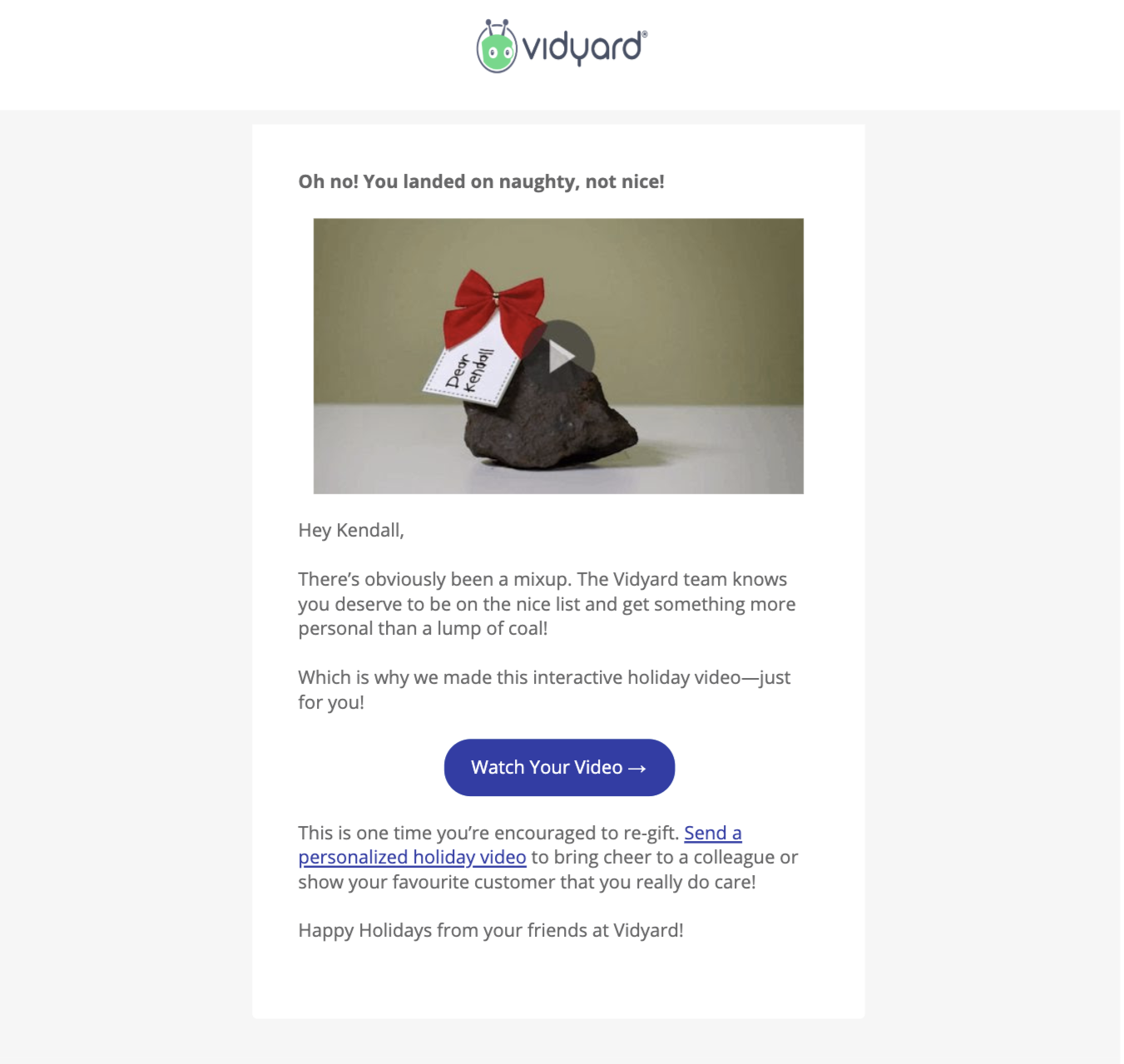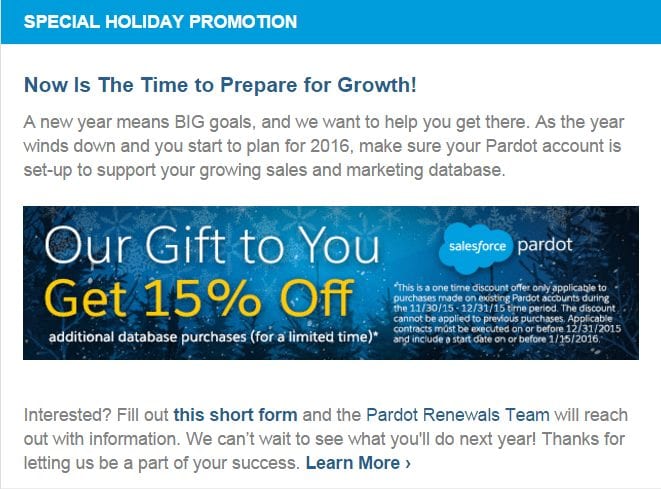
12 ways to leverage holiday email greetings for B2B sales (w/examples)
Traditionally, seasonal shopping and holiday sales are B2C centric—Santa Claus is known for making toys, after all, not Cloud ERP. But that doesn’t mean you should ignore the B2B email marketing opportunity and (properly) engage your clients and prospects with holiday greetings.
Nearly two-thirds of all buyers are more likely to open and read marketing emails during the holidays. Mostly because they’re looking for deals and discounts. What can you do to ensure your holiday greetings (and offerings) not only stand out in your prospective customers’ inboxes but also help drive sales?
Why use B2B email marketing this holiday season?
Forward-thinking businesses have been tapping into end-of-year B2B marketing for many years. The reasons are simple: businesses are looking to spend what remains of their annual budget, and are starting to plan out their corporate purchases for the upcoming year. These factors make the holiday season a perfect time to engage your leads and clients. Moreover, COVID-19 has changed the world quite a bit this year, creating a new environment for ABM and data-driven B2B funnels in which email marketing is a central tool.
If any one B2B marketing channel can be considered a “winner” in the new 2020 normal that has emerged, it’s email marketing. Open rates are up and engagement is holding despite higher-than-normal volumes of email traffic. Volumes that have been shown to turn customers off in previous years.
This trend only bolsters the domination of email as the primary channel for content distribution and lead nurturing in the B2B world—nine out of ten content marketers use email engagement as their primary performance metric.
So from 2020, and probably onward for a good period of time, B2B marketers can count on fewer bounced or buried emails, too: with so many businesses still in work-from-home mode, there aren’t as many employees away on vacation. It’s hard to be “out of office” when you live there.
Top 12 tips for driving B2B sales with holiday greeting emails
1. Plan ahead
The holiday season is fairly short, so you want to be ready as soon as possible with all your ducks in a row. This includes lead capturing tools, email analytics integration, and an up-to-date email database along with the publishing and tracking services you will need to use.
Determine the objective and audience for the campaigns you’ll be running, and think about how to time your emails. You might want to avoid sending emails in the lead-up to Black Friday or Cyber Monday to avoid getting lost in the noise—unless, of course, you’re participating in those sales days.
When you’re planning out your content and tactics, don’t forget the insights from your previous year’s campaigns. Now is the time to dig up that data and refresh your memory on what worked and what didn’t.
2. Deliver relevance with segmentation and targeting
The holidays can be a good opportunity to win over new customers and a perfect time to strengthen relationships with existing customers—but you wouldn’t use the same email marketing campaign for both groups.
Once you’ve decided on an audience for a particular campaign, make a list, update and expand it as necessary, and check it twice before you hit “send”. You don’t want to waste resources on outdated contacts, and more importantly, the whole world doesn’t share the same holiday seasons. Make sure you greet your subscribers with the right seasonal greetings for their region and culture.

At the same time, don’t miss out on the shared touchstones you may have with international customers. Black Friday sales take place in the Middle East and Africa, and Cyber Monday is a more or less global sales day.
3. Personalize
Everybody craves a little bit more human connection over the holidays. So why send out an obvious form letter when you can personalize it and look forward to six times the transaction rates? Personalized subject lines also draw more attention to emails sitting in crowded inboxes, making them 26% more likely to be opened. Don’t forget to add an excellent CTA and a holiday twist.

4. Aim for unspent 2020 budgets with end-of-year offers
At the end of the year, many departments will be left with “use it or lose it” money—unspent funds from their annual budgets that they can no longer use once their following year’s budgets take effect. Marketers who can figure out what these buyers are looking for and how to deliver it can make significant sales in relatively short order.
You may be able to capitalize on this opportunity by upselling to existing clients and offering unique, limited-time deals. A discount of 50% off a product upgrade can be a hard thing to pass up if you’re sitting on money that’s about to evaporate at the end of the month.

5. Help prospects make plans and resolutions for the New Year
New Year’s resolutions are all about making improvements and solving problems. When it comes down to it, isn’t that what your company does as well? Connect the dots between the goals your customers have for the coming year and how your products can help them achieve them. If you do it right, you’ve got a great marketing campaign for that otherwise-quiet period between Christmas and New Year’s Eve.
For example, some of your users may have indicated plans to expand the following year into new markets and might be very appreciative of a deal on a subscription upgrade that includes additional user licenses for the upcoming year.
6. Show gratitude to your customers and employees
For some businesses, going for the hard sell over the holiday season isn’t right for their customers or brand. That doesn’t mean they have to sit this one out. The holiday season is never a bad time to show some gratitude to your employees, your clients, and others in your industry.
A simple and sincere message can go a long way, but you can go ahead and make a bigger impression by providing clients with a small gift, like an ebook or a feature upgrade, or by highlighting an appropriate charitable organization.

7. Get personal
Many B2B customer relationships are built on personal connections, and the holidays offer you a chance to let people see the human side of your company. It can be a company video or an annual summary letter with a greeting from the CEO. Whatever form it takes, keep it tone-appropriate for your brand.

8. Create 12 days of relevant content
The Twelve Days of Christmas can be a creative theme to build a campaign around. You can create an email calendar or social media calendar that sends out an email with different content and offers for each of the twelve days. If your content is good and the offers provide real value? You’ll give your audience something to look forward to and sustain their interest over a longer period of time.

9. Add “seasonal sparkle”
There’s a time and place to get serious and personal—including in your email marketing—but the holidays are supposed to be fun, too. It’s okay to loosen up and let your campaigns reflect that, as long as you don’t stray too far from the image your brand projects.
If you’ve got genuine enthusiasm for the holidays, let it show in your overall digital presence. As long as you keep it professional, it can be endearing to some clients and it sets the right mood for your holiday marketing messaging. After all, especially in B2B, it’s all about multi-channel marketing.
10. Synchronize your holiday greetings
Time your holiday greeting emails to coincide with website, social, paid advertising, and other marketing tactics to ensure a cohesive holiday message. It’s okay to leave your tree up for weeks at home, but when your emails have switched over to New Year’s messaging it’s time to get the lights and icicles off of your website.
11. Measure everything and make use of the data
One of the best aspects of any marketing campaign is what it can teach you about running the next one. A/B testing subject lines and CTAs can be especially helpful here, and proper use of email-open signals can help you refine your strategy in real-time as you execute your campaign.
You just have to be quick about it—the B2B buying process may be long, but the holiday season is short. Whatever path you choose make sure to always test and measure the performance of your campaigns – be it paid or organic.
12. Make it timely and organized
Don’t just hit “send” on a million emails at once. A carefully-considered plan of when and how often to send emails makes it easier to adjust and optimize as you go. Be sure to take into account when your business will be closed or otherwise impacted by holiday hours, and communicate that information to your clients. If you’re going to solicit sales in the last week of December, there had better be people there to take them!
Armed with tools, data, and some holiday cheer, you stand to gain a profitable Q1 in 2021 through the use of intelligent and holistic holiday marketing strategies in Q4 2020. Email marketing is the spirit of the season this year, so put your best efforts forward while your prospects are receptive to it.


